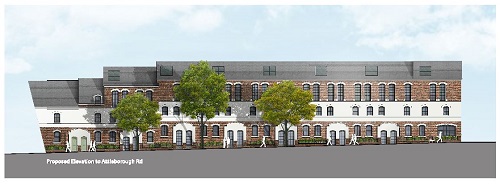First constructed in the 1840s, the original building was utilised as a ribbon factory and had a third storey, with elongated floor to ceiling windows. Meanwhile its two lower floors were split into cottages to house the workers.
In May 1968, the roof and top floor were removed from the building to facilitate the removal of a steam engine, which had previously been utilised to power the looms in the ribbon factory but never restored.
Sporting goods supplier Phillips-Tuftex took on the site in the 1900s, utilising it as warehouse and office space, but recognising the impractical and wholly inefficient configuration of the original cottage accommodation - comprising a maze of small interconnecting rooms- relocated in 2020 leaving the Albion Buildings vacant.
The extensions and development proposed by the current application are sensitive to the historic nature of the site. In the absence of measured drawings historic images have been analysed and the proposals include the re-instatement of the historic second floor, including matching historic eaves height, window placement and roof form.
Simon Robinson, director at Phillips-Tuftex Limited, said: “We strongly recognise the importance of retaining the historic significance of the site. If approved, the newly developed building will provide excellent accommodation in a prime location offering what will be highly sought-after living space with a really attractive look and feel, mixing the best of the old with new contemporary design.”
A prime location for development, the site is just an eight minutes’ walk from Nuneaton town centre with frequent bus services less than a minute’s walk away.
Megan Simpson, planner at Marrons who led the application, said: “It’s fair to say that the vacant building has been somewhat of an eyesore in the local area, so not only will this landmark development look to restore the historic building to its former glory, but it will offer much-needed homes in the area, which are perfect for couples and young professionals looking for something more often found in the larger cities of the UK.”
Designs were created by Haywards Architects.






























